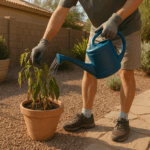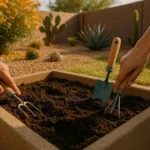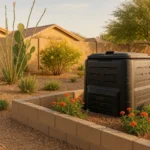Are you struggling to keep your potted plants alive in the blazing Gilbert heat? You’re not alone. Many Gilbert residents grapple with this problem every summer. But don’t worry, there are proven strategies you can use to revive your wilting plants and keep them thriving all season long.

Understanding the Effects of Heat on Potted Plants
Before we dive into the solutions, let’s first understand what heat does to your potted plants. The scorching summer temperatures in Gilbert can cause a series of issues for your green friends. The heat can quickly dry out the soil, leaving your plants thirsty and stressed. Additionally, intense sunlight can cause leaf scorch, a condition where leaves turn brown and crispy.
It’s also important to note that plants in pots are more susceptible to heat stress than those in the ground. This is because pots provide less insulation from the heat, causing the roots to heat up faster. Furthermore, pots have limited soil volume, which means they can’t hold as much water as the ground, leading to quicker drying out.
Choosing the Right Pots
Your choice of pots can greatly influence how well your plants can withstand Gilbert’s heat. Plastic pots, for instance, can get very hot in the sun, which can harm your plant’s roots. Consider using ceramic or terracotta pots instead. These materials stay cooler and allow for better air circulation around the roots.
Size is also an important factor. Larger pots hold more soil and thus, more water, which can help keep the roots cool and hydrated. However, don’t go too big as a large pot with a small plant will retain too much water and could lead to root rot.
Watering Techniques for the Heat
How and when you water your plants can make a huge difference in their ability to survive the Gilbert heat. It’s best to water your plants early in the morning before the heat of the day sets in. This allows the water to reach the roots and be absorbed before it evaporates. Avoid watering in the evening as this can create a damp environment that encourages fungal growth.
When watering, make sure to thoroughly soak the soil until water drains out of the bottom of the pot. This ensures that the water reaches the root zone where it’s most needed. Remember to check the moisture level regularly as potted plants may need watering more than once a day in extreme heat.
Providing Shade and Wind Protection
Providing some shade for your potted plants can go a long way in protecting them from the harsh Gilbert sun. Consider using a shade cloth or moving your pots to a location that gets afternoon shade. Be careful with delicate plants like ferns and orchids as they can get sunburned easily.
Wind can also be a problem as it can quickly dry out your plants. If your pots are in a windy location, consider using a windbreak like a fence, wall, or even other plants to protect them.
Using Mulch to Conserve Moisture
Mulch is a potted plant’s best friend in the heat. It acts as a barrier between the hot sun and the soil, reducing evaporation. It also helps to keep the soil temperature more stable. Consider using organic mulches like straw, compost, or shredded bark. These not only conserve moisture but also improve the soil structure as they break down.
Apply a 2-3 inch layer of mulch on the surface of the soil, making sure not to cover the stem of the plant. Reapply as necessary throughout the season to maintain the benefits.
Taking Care of Your Potted Plants After Heat Stress
If your potted plants have already suffered from heat stress, don’t despair. With a little care, you can nurse them back to health. Begin by trimming off any dead or dried parts to prevent the spread of disease. Then, rehydrate the plant by soaking the pot in a tub of water until the soil is thoroughly wet.
Remember, recovery takes time. Keep your plant in a shady location and continue with regular watering and care until it bounces back. In some cases, you might need to repot the plant in fresh soil to give it a fresh start.
Reviving wilting potted plants in Gilbert’s heat is a challenge, but with the right strategies, it’s entirely doable. Implement these tips in your plant care routine and watch your potted beauties flourish even in the harshest summer conditions.






